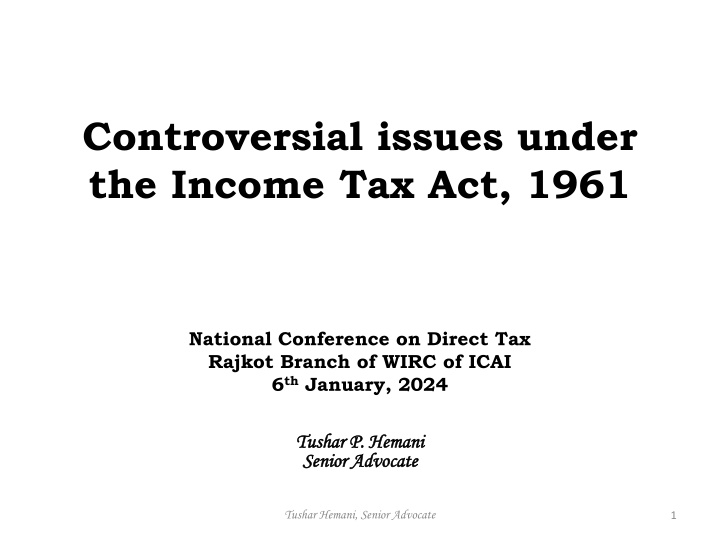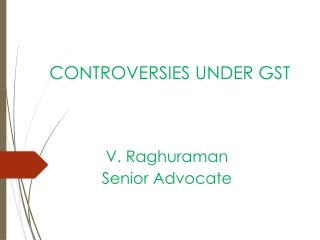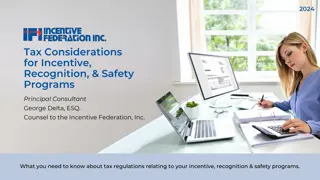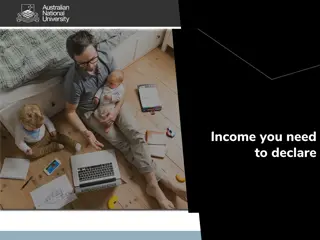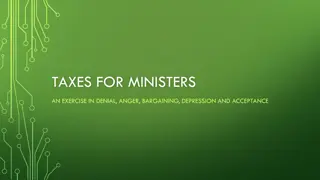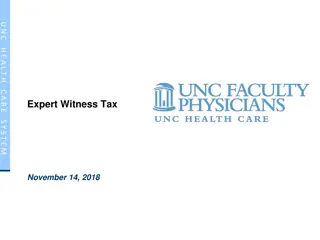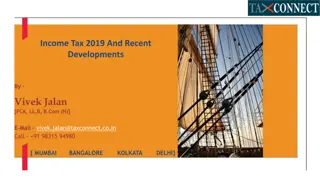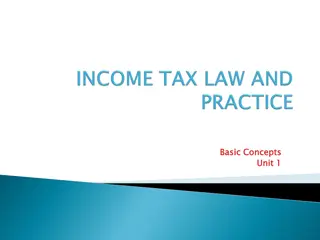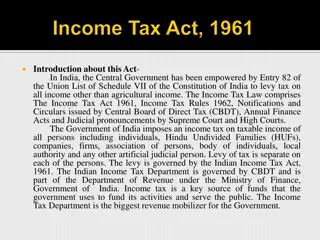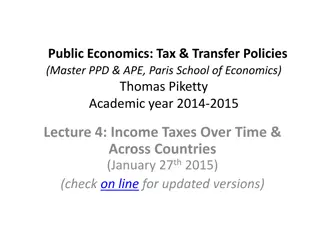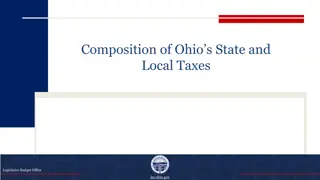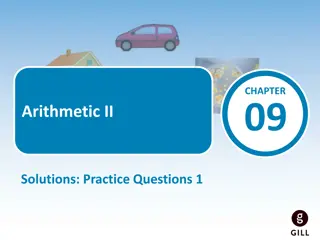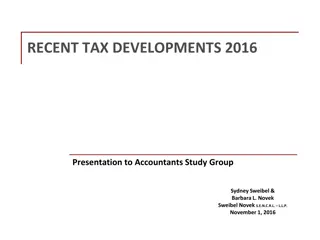Recent Developments in Income Tax Controversies Addressed by Senior Advocate Tushar Hemani
Explore controversial issues under the Income Tax Act, 1961 discussed at the National Conference on Direct Tax. Senior Advocate Tushar Hemani sheds light on topics such as bogus purchases, fake invoices, and burden of proof in tax matters, offering valuable insights and legal perspectives. Discover key considerations, evidentiary requirements, and case law implications for taxpayers facing scrutiny in tax assessments.
Download Presentation

Please find below an Image/Link to download the presentation.
The content on the website is provided AS IS for your information and personal use only. It may not be sold, licensed, or shared on other websites without obtaining consent from the author.If you encounter any issues during the download, it is possible that the publisher has removed the file from their server.
You are allowed to download the files provided on this website for personal or commercial use, subject to the condition that they are used lawfully. All files are the property of their respective owners.
The content on the website is provided AS IS for your information and personal use only. It may not be sold, licensed, or shared on other websites without obtaining consent from the author.
E N D
Presentation Transcript
Controversial issues under the Income Tax Act, 1961 National Conference on Direct Tax Rajkot Branch of WIRC of ICAI 6thJanuary, 2024 Tushar P. Hemani Tushar P. Hemani Senior Advocate Senior Advocate Tushar Hemani, Senior Advocate 1
Bogus Purchase Fake Invoice Bogus Billing Tushar Hemani, Senior Advocate 2
Fake Invoice - IT Accommodation Billing Fake Billing Genuine transaction becomes billing transaction due to lack of proof or supplier related issues; Supplier not traceable Supplier never existed Supplier is alleged to be bogus Supplier is proved to be bogus Supplier s GST registration is cancelled prospectively or retrospectively Tushar Hemani, Advocate 3
PO & Invoice [Invoice Reference Number (IRN)]; E-way bill; Transport receipt, affidavit of driver; Weight bridge slip; Toll payment receipts; RFID vehicle tracking details; GSTR1 of Seller, GSTR2B of buyer, GSTR3B filed by both the parties; Correspondence with supplier; CCTV footage; payment details and relevant bank statement; Internal documents e.g. Inward register, quantity details etc. Tushar Hemani, Senior Advocate 4
Quantify Details Even though the assessee was a scrap dealer, the addition u/s. 69C on account of bogus purchases was held not justified as assessee had maintained trading account with purchases, opening stock, sales and closing stock and no discrepancy in such quantitative tally was found - Manoj Sharma v. ITO [2019] 103 taxmann.com 105 (Delhi - Trib.) What if quantity details are not maintained; quantitative tally of Tushar Hemani, Senior Advocate 5
Burden of Proof Where transportation bills, confirmed copy of account and VAT Registration of sellers as also their income-tax Return and payment was made through cheques, impugned purchases could not be disallowed - CIT v. Odeon Builders (P.) Ltd. 418 ITR 315 (SC). Where assessee brought on record name and address of parties, their PAN, TDS deducted, date of bills, details of cheques issued, etc., to establish genuineness of purchase transactions, in such a case, he could not be held responsible for parties not appearing in person and, thus, addition so made under section 69C deserved to be deleted - Pr. CIT v. Chawla Interbild Construction Co. (P.) Ltd. 412 ITR 152 (Bom). assessee had submitted purchase bills, Tushar Hemani, Senior Advocate 6
Natural Justice Merely on suspicion bases on information received from sales Tax authority, assessing officer could not make addition on account of bogus purchases without carrying out independent enquiry and affording opportunity to Assessee to controvert statements made by seller - Pr. CIT v. Shapoorji Pallonji & Co. Ltd. [2022] 288 Taxman 661 (SC). No addition can be made in respect of bogus purchases merely on the basis of material / information received from the Maharashtra Sales Tax Department without providing such material to the assessee or affording an opportunity to cross examine the concerned parties - Shailesh Keshavlal Shah vs. ITO ITA 1877 to 1879/Ahd/2015. Tushar Hemani, Senior Advocate 7
Sales whether accepted? Bombay High Court in the case of Pr. CIT v. Nitin Ramdeoji taxmann.com 546 held that Where AO made addition by disallowing expenses on purchases on ground that an information was received from sales tax department beneficiary of accommodation entries on account of bogus purchases, in absence of AO not disputing corresponding purchases could not be treated as bogus and, thus, impugned addition made on account of bogus purchases to be deleted. Lohia [2022] 145 that assessee was sales transactions, Tushar Hemani, Senior Advocate 8
Percentage disallowance CIT vs La Medica 250 ITR 575 (Del) 100% Sanjay Oil Cake Ind vs CIT 316 ITR 274 (Guj) 25% Pr. CIT v. Suraj Infrastructures (P.) Ltd [2023] taxmann.com 192 (Bombay) 12.5% Pr. CIT v. Rakesh Kailashchand taxmann.com 82 (Gujarat) 6% CIT vs. Gujarat Ambuja Export Ltd. [2014] 43 taxmann.com 244 (Gujarat) 5% 156 Jain [2023] 156 Tushar Hemani, Senior Advocate 9
Other Approaches Dhondiram Naryan Limbhore vs Pr.CIT 153 taxmann.com 539 (Bom) addition was to be limited to extent of bringing GP rate on tainted purchases at same rate as applied in other genuine purchases. Nehal Hsamukhari Gandhi vs. DCIT ITA 2578/Ahd/2017 - NP Tushar Hemani, Senior Advocate 10
Other Issues Distinction between a trader, manufacturer and/or consumer. Rejection of books of accounts 145(3); GP/NP comparison (history & Industry average); Disallowance u/s (expenditure incurred and Assessee offers no explanation) Impact of S. 40A(3) [Hynoup - 290 ITR 702 (Guj)]; GP addition vs addition as percentage of bogus purchases 69C justified? Tushar Hemani, Senior Advocate 11
Curious case of N K Ind Ltd [2016] 72 taxmann.com 289 (Gujarat) Whether 25% or 100% disallowance is confirmed by HC Before Guj High Court, both Revenue and Assessee were in appeal. Assessee was in appeal against confirmation of disallowance @ 25% out of purchases whereas Revenue was in appeal against deletion of 75% out of purchases by the ITAT. Hon ble High Court while dismissing both the appeals, gave the following finding: Tushar Hemani, Senior Advocate 12
6. The Tribunal in the case of Vijay Proteins Ltd. (supra) has observed that it would be just and proper to direct the Assessing Officer to restrict the addition in respect of the undisclosed income relating to the purchases to 25% of the total purchases. The said decision was confirmed by this Court as well. On consideration of the matter, we find that the facts of the present case are identical to those of M/s. Indian Woollen Carpet Factory (supra) or Vijay Proteins Ltd. (supra) In the present case the Tribunal has categorically observed that the assessee had shown bogus purchases amounting to Rs. 2,92,93,288/- and taxing only 25% of these bogus claim goes against the principles of Sections 68 and 69C of the Income Tax Act. The entire purchases shown on the basis of fictitious invoices have been debited in the trading account since the transaction has been found to be bogus. The Tribunal having once come to a categorical finding that the amount of Rs. 2,92,93,288/- represented alleged purchases from bogus suppliers it was not incumbent on it to restrict the disallowance to only Rs. 73,23,322/-. xxx 9. In view of the above, the impugned judgment and order passed by the Tribunal is modified accordingly. Hence, the present Tax Appeals are dismissed. Tushar Hemani, Senior Advocate 13
Assessee preferred SLP against confirmation of 25% which got dismissed. [2017] 84 taxmann.com 195 (SC) Subsequently, Gujarat distinguished judgement in the case of N K Ind. Ltd. In the following cases: [2019] 106 taxmann.com 316 (Gujarat) Pr. CIT v. Synbiotics Ltd. [2023] 148 taxmann.com 154 (Gujarat) Pr. CIT v. Surya Impex High Court itself Tushar Hemani, Senior Advocate 14
Bogus Billing GST vs IT During the course of an IT search, material is found indicating unaccounted turnover outside the books. IT department proposes to add the said turnover on the basis of the seized documents. Assessee wants to surrender only GP on this unaccounted turnover. However, Assessee is worried about GST consequences. Kindly advice. Tushar Hemani, Senior Advocate 15
During the course of GST search, material is found indicating purchases registration were found to be cancelled ab-initio as they were found to be indulging into bogus billing without actual supply of material. Assessee is asked to reverse the ITC claimed from such supplier on the ground that the same is fake and fraudulent. Assessee wants to surrender such ITC and pay the necessary amount into the Govt. treasury. However, Assessee is worried about IT consequences. Kindly advice. from dealers whose Tushar Hemani, Senior Advocate 16
In an income tax assessment, sales are treated as accommodation entries and addition to that effect is made u/s 68 of the IT Act. GST department on the strength of such AO, want to treat the said sales as billing transaction and deny ITC in the hands of the purchaser. Recovery notices for wrong claim of ITC is issued against the said purchaser. Kindly advice. (Circular No. 171/03/2022-GST dated 06/07/2022, Example 3) Tushar Hemani, Senior Advocate 17
Interplay between IBC & Income Tax Tushar Hemani, Senior Advocate 18
Tata Steel Ltd. vs. DCIT W.P.(C) 13188/2018 Facts: Assessment order for AY 2001-02 was passed on 28.02.2003. Addition was confirmed upto High Court. SLP has been accepted by Supreme Court & is pending for adjudication. Assessment order vis- -vis AY 2009-10, 2010-11 & 2013-14 was passed on 30.12.2016. CIT(A) dismissed the first appeal & also triggered penalty proceedings u/s. 271(1)(c). Second appeal with ITAT is pending. Insolvency proceedings were triggered against the assessee. Petition was admitted by NCLT on 26.07.2017 Public announcement was published on 28.07.2017. Tushar Hemani, Senior Advocate 19
Revenue lodged its claims to Interim Resolution Professional (IRP) on 28.09.2017, 24.10.2017 & 25.10.2017 for AY 2009- 10, 2010-11 & 2013-14 but not for AY 2001-02. Penalty order u/s. 271(1)(c) vis- -vis AY 2009-10, 2010-11 & 2013-14 was passed on 23.04.2018. Resolution Plan was admitted by NCLT on 15.05.2018. Notice u/s. 221(1) was issued on 28.08.2018 requiring assessee to deposit tax for all 4 AYs & seeking response as to why penalty u/s. 221(1) shall not be levied. Revenue lodged an updated Professional (RP) on 20.09.2018 wherein the claim for the demand of tax for AY 2001-02 & penalties for all 4 assessment years were added. claim with Resolution Tushar Hemani, Senior Advocate 20
Objections were filed by assessee on 26.09.2018 against notice u/s. 221(1) dated 28.08.2018. Order u/s. 221(1) was passed on 17.10.2018 rejecting the objections filed by the assessee. Assessee filed a writ petition against notice u/s. 221(1) dated 17.10.2018 & order dated 17.10.2018. Held: In our opinion, the stand taken by the revenue that the demands for the AYs in issue were not outstanding at the time of the RP being accepted, if agreed with, would amount to splitting hairs. Tushar Hemani, Senior Advocate 21
Therefore, the facts on record, in our opinion, not only disclose that the revenue had knowledge of the CIRP, but that it took steps to lodge its claims with regard to three out of the four AYs, on the footing that the amounts reflected in the assessment order were due and payable by BSL. Insofar as AY 2001-02 is concerned, the revenue did not lodge any claim before the RP was approved. The demand qua AY 2001-02 (along with the penalty imposed qua all four relevant AYs) was communicated as an additional claim on 20.09.2018, only after the RP was approved on 15.05.2018. In the ordinary course, the claim would get extinguished under the provisions of the 2016 Code, as the approved RP obviously made no reference to it. Tushar Hemani, Senior Advocate 22
We are of the opinion that dues payable to creditors, including statutory creditors, for the periods which precede the date when the RP is approved, can only be paid as per the terms contained in the RP. In cases where no provision is made for claims lodged on behalf of the creditors, or there is failure to lodge a claim with the Resolution Professional, all such claims stand extinguished. When one examines the provisions of Section 238 of the 2016 Code, the underlying purpose of the provision comes through. Section 238 clearly states without any ambiguity that the provisions of the 2016 notwithstanding anything inconsistent contained in any other law for the time being in force, or any instrument having effect under any such law. Code shall have effect, Tushar Hemani, Senior Advocate 23
Thus, where matters covered by the 2016 Code are concerned [including insolvency resolution of corporate persons] if provisions contained therein are inconsistent with other statutes, including the 1961 Act, it shall override such laws. If such an approach is not adopted, it will undermine the entire object and purpose with which the Legislature enacted the 2016 Code. Thus, the impugned notice & order dated 28.08.2018 & 17.10.2018 respectively, are unsustainable in law and, hence cannot be enforced. Tushar Hemani, Senior Advocate 24
Rishi Ganga Power Corporation Ltd. vs. ACIT W.P.(C) 3167/2020 Facts: Notices u/s. 143(2) were issued on 09.08.2018, 28.09.2018 & 30.09.2018 followed by a notices u/s. 142(1) dated 14.03.2019, 22.10.2019 & 04.11.2019. None of the notices were complied, hence a penalty order u/s. 272A(1)(d) was passed on 21.11.2019. Eventually an ex-parte assessment order u/s. 143(3) came to be passed on 06.12.2019. Meanwhile a petition was filed under IBC against the assessee which was admitted by NCLT on 25.01.2018. Consequent to insolvency announcement was made on 31.01.2018 which was published in various newspapers on 02.02.2018 & 03.02.2018. proceedings, public Tushar Hemani, Senior Advocate 25
No claims were lodged by the Revenue being an operational creditor, with Resolution Professional (RP). Resolution Plan was approved by NCLT on 13.11.2018. On 11.02.2020, the new management who has taken over the affairs of the assessee, wrote to AO, explaining reasons for non-participation proceedings and requesting the AO for deletion of additions made thereunder. Since there was no response from revenue, the assessee filed a writ petition in the High Court. in assessment Tushar Hemani, Senior Advocate 26
Held: Revenue argued that it has not lodged claims with the RP pursuant to public announcement on 31.01.2018 because claims had not fructified into demands on that date. The assessment order resulting in demand was passed on 06.12.2019. IBBI (Insolvency Resolution Process for Corporate Persons) Regulations, 2016 require operational creditors to submit their claim with proof to the IRP, which are not necessarily claims that have been adjudicated. As per Regulation 7 of 2016 Regulations, operational creditors must file their claims with proof in the prescribed form i.e. Form B. Regulation 7, when read alongside particulars sought against Sr. No. 6 of Form B, would drive home the point that it can include claims that are disputed. Tushar Hemani, Senior Advocate 27
Furthermore, the definition of claim u/s. 3(6)(a) of the 2016 Code puts these aspects beyond doubt: 3. Definitions.- In this Code, unless the context otherwise requires,- xxx xxxxxx (6) claim means- (a) a right to payment, whether or not such right is reduced to judgment, fixed, disputed, undisputed, legal, equitable, secured or unsecured; Tushar Hemani, Senior Advocate 28
Thus, having regard to the fact that the revenue had not lodged its claim, despite the publication of the public announcement by the Resolution Professional inviting claims from statutory/operational creditors such as the revenue, no provision could be made [even if it may otherwise have been possible] in the approved RP. The terms contained in the approved RP are binding on all stakeholders, including those who could have filed claims but chose not to lodge them. The revenue, having failed to lodge its claim, cannot enforce the impugned orders and notices, given the binding nature of the approved RP. creditors, including Tushar Hemani, Senior Advocate 29
Section 31 of the 2016 Code, among other things, stipulates that once the RP is approved, it shall be binding on the corporate debtor and its employees, members, and creditors, which includes the Central Government, State Government, Local Authority to whom a debt in respect of payment of dues arising under any law for the time being in force and also on authorities to whom statutory dues are owed. Accordingly, the assessment and penalty orders were quashed. Tushar Hemani, Senior Advocate 30
TUF Metallurgical P. Ltd. & ors. vs. UOI & ANR W.P.(C) 10528/2022 Facts: A public advertisement was notified u/s. 15 of IBC pertaining to initiation Resolution Process (CIRP) of Albus India Ltd. declaring last date for submission of claims as 21.01.2019. No claim was filed by the Revenue during the CIRP. Resolution plan was filed with NCLT on 20.05.2019 and the same was approved by NCLT on 05.11.2019. Pursuant to Resolution Plan dated 20.05.2019, the assessee took over the management of Albus India Ltd. On 02.12.2019, Assistant Commissioner of Income Tax was intimated about the approval of Resolution Plan & change of management of Albus India Ltd. of Corporate Insolvency Tushar Hemani, Senior Advocate 31
Thereafter, the Revenue passed the assessment order & demand notice on 12.12.2019 for AY 2017-18, raising a demand of Rs. 9,71,79,357. Penalty orders u/s. 272A(1)(d), 270A & 271AAC(1) were passed on 10.09.2021, 16.03.2022 & 25.03.2022 respectively levying various penalties. Assessee challenged the above orders by filing a writ petition before the High Court. Held: Revenue did not file any claim till the last date for submission of claims (21.09.2019) or even thereafter. Tushar Hemani, Senior Advocate 32
Reliance was made to the case of Ghanshyam Mishra & Sons Pvt. Ltd. vs. Edelweiss Asset Reconstruction Ltd. (2021) 9 SCC 657, wherein the Hon ble Apex Court held that the words otherstakeholders would squarely cover the Central Government, any State Government or any local authorities. The legislature noticing that on account of obvious omission certain tax authorities were not abiding by the mandate of I&B Code and continuing with the proceedings, has brought out the 2019 Amendment so as to cure the said mischief. We therefore hold that the 2019 Amendment is declaratory and clarificatory in nature and therefore retrospective in operation. Tushar Hemani, Senior Advocate 33
Hence, the Honble Delhi High Court rejected the argument of the Revenue that being State exchequer, it cannot be bound by the Resolution Process provisions of the Code. The tax claims pertaining to AY 2017-18 stood extinguished on approval of Resolution Plan dated 05.11.2019. The writ petition is allowed and the impugned notices and orders are set aside. Tushar Hemani, Senior Advocate 34
Reopening Tushar Hemani, Senior Advocate 35
Ganesh Dass Khanna vs ITO [WP(c) 11527/2022, dated 10/11/2023] Facts: Notices u/s 148 of the unamended IT Act came to be issued for AY 2016-17 on 30.6.2021) & AY 2017-18 on 28.06.2021. Pursuant to judgement of Supreme Court in case of Union of India v. Ashish Agarwal [2022] 444 ITR 1 (SC), revenue issued another notice under section 148A(b) dated 20-5-2022. Assessee contended that reassessment proceedings triggered against it were time-barred as limitation period of three years qua relevant assessment years had expired and alleged escapement was below Rs.50 lacs. Tushar Hemani, Senior Advocate 36
Issue: After the coming into force of FA 2021, in cases where, for the relevant AY, the alleged escaped income was less than Rs.50 lakhs, notice under Section 148 could only be issued for commencement of reassessment proceedings within the limitation period provided in Clause (a) of Section 149(1) of the amended 1961 Act. Consequently, for AYs 2016-17 & 2017-18, whether the order passed under Section 148A(d) and the consequent notice issued under Section 148 of the amended 1961 Act falls foul of the limitation prescribed in Clause (a) of Sub- Section (1) of Section 149? Thus, in the ordinary course, the limitation for AY 2016-17 would expire on 31.03.2020; likewise, for AY 2017-18, the end date for the culmination of the limitation period would be 31.03.2021. The revenue seeks to take recourse to the provisions of Section 3(1) of TOLA and the Notifications issued thereunder, from time to time, which, in effect, extended the end date for completion of proceedings and compliances up until 30.06.2021. Tushar Hemani, Senior Advocate 37
Further following arguments were raised by the Revenue: o First, the observations made in the judgment of the Supreme Court in Ashish Agrawal s case. o Second, the observations made in paragraphs 98 and 99 by the coordinate bench in Mon Mohan Kohli s case. o Third, the extension of the time limit, as noticed hereinabove, granted via the subject Notifications by the Central Government in the exercise of powers under Section 3(1) of TOLA. o Fourth, the third and fourth provisos appended to Section 149 of the 1961 Act, which provide for the exclusion of periods referred to therein, which, if excised, would bring the impugned notices and orders within the limitation prescribed under Section 149(1)(a) of the amended 1961 Act. o Fifth, the issue raised before the Court is no longer res integra, given the judgments rendered by the coordinate bench in Touchstone and Salil Gulati. Tushar Hemani, Senior Advocate 38
Held: Concededly, these notices were issued between 01.04.2021 and 30.06.2021, by which time limitation of three years under section 149(1)(a) had already expired and, thus, same were barred by limitation at the inception itself. Furthermore, the reference made in paragraphs 6.1 and 6.2(ii) of the Instruction dated 11.05.2022, to the extent it propounds the travel back in time theory, is declared bad in law. Tushar Hemani, Senior Advocate 39
Kankanala Ravindra Reddy vs. ITO [2023] 156 taxmann.com 178 (Telangana) Facts: For the AY 2016-17, the jurisdictional AO issued a notice to the assessee under section 148A and proceeded to reassess the income of the assessee and passed a further order under section 148A(d) and issued a reopening notice under section 148. The assessee filed a writ petition contending that the reassessment has to be conducted in a faceless manner, rather than jurisdictional officer as was provided under section 144B and in accordance with the scheme enacted by the Central Government under section 151A. being assessed by the Tushar Hemani, Senior Advocate 40
Held: On preferring a writ before the Hon ble High Court, it was observed that the Hon ble Supreme Court in the case of Union of India vs. Ashish Agarwal 444 ITR 1, ordered that notices issued under section 148 after enactment of Finance Act, 2021 shall be deemed to be notices issued under section 148A i.e. new provision inserted by Finance Act, 2021. However, the Hon ble Supreme Court has only permitted the revenue to proceed further with reassessment proceedings under the amended provisions of law, more particularly, as amended by Finance Act, 2021. Tushar Hemani, Senior Advocate 41
It was observed that certain provisions of the Income- tax Act which stood amended with effect from 1-4-2021 by virtue of the Finance Act, 2021. Section 144B inserted by virtue of the Finance Act, 2021, with effect from 1-4-2021 provides for faceless assessment and subsection (1) of the said newly inserted section 144B is an non obstante clause. Sub-section (1) of section 151A was inserted with effect from 1-11-2020 which refers to faceless assessment of income escaping assessment. Section 130 was amended so far as conferring jurisdiction of income tax authorities in light of faceless assessment procedure. Tushar Hemani, Senior Advocate 42
In furtherance to the powers conferred under sub- sections (1) and (2) of section 130, CBDT framed a scheme called as the 'Faceless Jurisdiction of Income- tax Authorities Scheme, automated allocation. Further, CBDT again in exercise of its powers conferred under sub-sections (1) and (2) of section 151A framed another scheme called as the e-assessment of Income Escaping Assessment Scheme, 2022, which defines automated allocation and the scope of the scheme again has been envisaged in section 3 of the said scheme. 2022. which defines Tushar Hemani, Senior Advocate 43
After the introduction of the above two schemes, it becomes mandatory for the revenue to conduct/initiate proceedings pertaining to reassessment under sections147, 148 & 148A in a faceless manner. Proceedings under section 147 and section 148 would now have to be taken as per the procedure legislated by the Parliament reopening/reassessment i.e., proceedings under section 148A. In the instant case, both the proceedings i.e., the impugned proceedings under section 148A, as well as the consequential notices under section 148 were issued by the local jurisdictional officer and not in the prescribed faceless manner. The order under section 148A(d) and the notices under section 148 are issued on 29-7-2022, i.e., after the 'Faceless Jurisdiction of the Income-tax Authorities Scheme, 2022 and the 'e-Assessment of Income Escaping Assessment Scheme, 2022' were introduced. in respect of Tushar Hemani, Senior Advocate 44
In the instant case, undisputedly the department has not proceeded against the petitioner under the substituted provisions of the Finance Act, 2021. Rather, it proceeded with the unamended provisions of law. Hence, the impugned notice was set aside/quashed. Tushar Hemani, Senior Advocate 45
143(1) followed by 143(3) Tushar Hemani, Senior Advocate 46
NSE Ltd. vs. DCIT ITA No. 732/Mum/2023 Facts: Return of income was processed u/s. 143(1) disallowing an expenditure marked as capital expenditure in the tax audit report without considering the response of the assessee to proposed adjustments u/s. 143(1)(a) Rectification u/s. 154 was filed, however no order was made by CPC, hence an appeal was filed before CIT(A). Meanwhile, order u/s. 28.09.2022 where no query was raised w.r.t. issue of allowability of such expenditure. Thereafter CIT(A) passed his order on 12.01.2023 dismissing the assessee s appeal against adjustment u/s. 143(1). 143(3) was passed on Tushar Hemani, Senior Advocate 47
Held: The ITAT observed that neither assessee s response to proposed adjustment was considered, nor application u/s. 154 was disposed of, amounting to violation of proviso 1 and 2 of the section 143(1) and making whole action null and void. Further, as the case of assessee was scrutinized u/s. 143(2) and assessment order u/s. 143(3) was passed, technically the doctrine of merger comes into picture, therefore the impugned adjustment by CPC gets merged into order passed u/s. 143(3) of the Act and order passed u/s. 143(3) only survives. Hence, the whole issue becomes academic including the order passed by CIT(A). As far as reporting by Tax Auditor is concerned, maybe he has been appointed by the assessee, still his independence is always assumed and he is always free to give his own legal opinion, but the same is not binding on assessee or revenue. Tushar Hemani, Senior Advocate 48
Controversies u/s 197 of the Act Tushar Hemani, Senior Advocate 49
ST Engineering Electronics Ltd. vs. ACIT ITA No. 755/Chny/2022 Facts: Assessee has entered into fixed price sub-contract with the awardee of contract for undertaking signaling, platform screen doors & telecommunication work for Chennai Metro Rail Project. Assessee follows percentage of completion method (POCM) as per AS-7. Assessee has obtained lower deduction certificate u/s. 197 by providing estimated costs & revenue details for FY 2012-13 till FY 2017-18 until which contract was expected to be completed. Projected revenue under application u/s. 197 for FY 2017-18 was Rs. 2587.75 lakhs, however the revenue as per financial statements was Rs. 1146.03 lakhs along with a contract loss of Rs. 495.65 lakhs. Tushar Hemani, Senior Advocate 50
